
Around Thanksgiving of 1949, Richard Watts moved from Philadelphia to Anchorage with his family. He was 3. His father had sold his stake in a nightclub and came to Alaska a few months before his family to take a construction job, inspired by promising talk from soldiers who had returned from the territory.
“He had heard about this place called Alaska where you could make some money,” Watts said of his dad. “You had to work for it, but there was jobs available.”
The Watts family is African American and part of a demographic transformation that reshaped Anchorage after World War II. Federal investment in Alaska poured money into the territory, and waves of workers arrived to build, among other things, the military bases. Thousands of those who arrived were Black, and by one estimate, in 1954 roughly one-sixth of the growing city was African American.
This was the eve of the era of civil rights, and discrimination against Black people and Alaska Natives in renting and buying housing was common. As the city grew, so did the use of restrictive covenants, which were attached to thousands of deeds, forbidding the sale of property to minorities.
The Civil Rights Act — the one which prohibited housing discrimination as part of the Fair Housing Act — wasn’t passed until 1968. Even after it passed, the covenants stayed on the books.
Thousands of homes in Anchorage still have them.
David Reamer is a historian in Anchorage who has looked through hundreds of deeds that included discriminatory covenants barring the sale of homes to anyone who wasn’t white. He found them in neighborhoods all over town.
“Sand Lake, Spenard, South Addition, North Star, parts of Fairview, Rogers Park, Airport Heights, Nunaka Valley,” Reamer said.
Members of the Anchorage Assembly are developing a plan for dealing with those covenants.

Watts said his family moved into a home on Fifth Avenue, after living at the downtown Polar Hotel for a few weeks while sorting out housing.
“Right there where OfficeMax is right now,” Watts said. “If you go into OfficeMax’s front door right now, that’s probably where our house was.”
From the boom years after the war into the 1960s, most of Anchorage’s Black community lived in the neighborhood known today as Fairview, which at one point included an unincorporated portion known as Eastchester Flats, according to Reamer.
Pointing to figures used by professional surveyors, Reamer said that in 1952, Anchorage’s population was 30,000 to 35,000. Almost all of the 5,000 or 6,000 African Americans lived in the Flats, with some others scattered through downtown and on homesteads in what has become the city’s Midtown, he and his co-author wrote in a recently published academic paper.
“There was no housing development in Anchorage that a Black could live in,” Watts said. One of the reasons many Black families homesteaded, he explained, was because it didn’t involve restrictive covenants or bank loans.
Watts said that, with a few exceptions, Black and Alaska Native residents were confined to living in just one part of town.
“One thing about discrimination in Anchorage, Alaska, versus discrimination in the Lower 48: In the Lower 48, it was in your face. In Anchorage, Alaska, it was hidden,” he said.
Watts said there were a number of ways this played out. Obtaining a bank loan ranged from difficult to impossible. Newspaper ads for rentals would often explicitly say “whites only.” Real estate brokers always seemed to have found a tenant just before you inquired about a place, Watts said.
“They wouldn’t say, ‘We don’t rent to Blacks or Natives.’ They’d say, ‘We’ve already rented it,’” he recalled. “Everybody knew what was going on. That’s just the way it was.”

In addition to the actual deeds, Reamer interviewed people who lived through the time period. And the researchers found a number of 1980s cassette tape recordings on which then-KSKA reporter Bruce Melzer interviewed Black residents about race relations and housing discrimination.
“I stopped to look at some property,” resident Ocia Mae Curry told Melzer. “The man said flatly to me, ‘This property is not for sale to you.’ I said, ‘What do you mean, to me?’ He said, ‘Well, you go to your people and buy property if you want property.’”
She and others interviewed spoke of many of the same tactics used to keep Black residents from living where they wanted.
Another challenge was building supplies: There weren’t many available. A lot of the housing stock in the boom years was built by developers who had access to capital and financing.
Joe Jackson, a realtor Melzer interviewed, said without bank loans available, many minorities built or expanded their homes out of material scrounged from military bases and dumps. As a result, a lot of the housing stock was abysmal.
“It wasn’t the kind of a house that you would call ‘house,’” Jackson said. “It was a shack. Actually, a crate that was shipped here with big parts for the Air Force.”
Houses made of salvaged lumber, tar paper and other cast-off material didn’t accrue much equity, so property ownership for many residents didn’t translate to wealth or upward mobility. In many cases, the land was much more valuable than the structures on it. That was especially true after Eastchester Flats fared well in the 1964 earthquake.
In his article, Reamer traced the relative success of the neighborhood surviving the disaster to its eventual demise. Not long after the quake, the city aggressively moved to redevelop the Flats, forcing out many of its residents and scattering the Black community to neighborhoods all over town.
Reamer recently presented his research to members of the Anchorage Assembly, some of whom are formulating a measure to address all the covenants still in place.
Right after he spoke, Assembly Member Meg Zaletel looked up the documents attached to her own home in Rogers Park. To her surprise, she found a covenant.
“It basically is one where it’s not blatant. It’s like hidden racism built into the covenant,” she said. “It’s worded in such a way that it’s obvious people of color are not welcome.”
Zaletel said finding out her family’s home is tied to such a contract was all the more troubling because her daughter is Black. And even though the discriminatory parts of the covenant are no longer legally enforceable, Zaletel believes policymakers need to figure out a way to address the town’s historical record on racism in housing in a more concerted way.
“I think we need to preserve the record,” she said. “When you simply just go and correct the record to update it into current terms, you lose the historical perspective. I think it’s good to know where did it happen in Anchorage, who was marginalized.”
Zaletel isn’t sure exactly what shape an eventual Assembly measure will take. But she wants community councils representing neighborhoods across city to participate.
